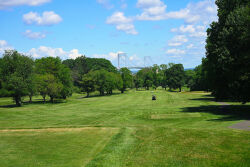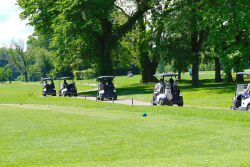Clearview Park Golf Course
Clearview Park and Golf Course
Clearview Park and Golf Course was founded in 1925, and is bounded by the Clearview Expressway, 23rd Avenue, 202nd Street, and Bell Boulevard. Originally named the Clearview Golf and Yacht Club, the establishment served as an exclusive retreat for New Yorkers. One notable member was the renowned New York State Governor Alfred E. Smith (1873-1944). Landscape architect Willie Tucker designed the golf course, which lies on gently rolling terrain. The course is located by Little Neck Bay and is aptly named for its views of the East River and the Long Island Sound.
On June 25, 1931 the City of New York purchased this property from the Clearview Golf and Yacht Club for $940,000. The Board of Estimate placed the course under Parks jurisdiction on the day of purchase. Between 1935 and 1940, Parks redesigned the entire course and built new club facilities. In 1957, the Triborough Bridge and Tunnel Authority acquired lands on the eastern side of the property to be used in the construction of Clearview Expressway. That year, the installation of a new course drainage system began. In 1983, Parks selected American Golf Corporation to manage the course as a public amenity under a concession agreement.
Today, Clearview Park and Golf Course is a public 18-hole course located about 15 miles from midtown Manhattan. The somewhat hilly course contains both straight, open fairways as well others lined with trees and forest. It is designed for beginner to intermediate level players, and par ranges from 3 to 5 strokes. The course’s signature hole is #17, which is a 395-yard, par 4 hole offering spectacular views of the Long Island Sound and Throgs Neck Bridge. The course’s longest hole is #2 at 473 yards. The facility includes such amenities as a pro shop, lessons, clinics, a clubhouse, lockers, a snack bar, a lounge/bar, and a snack cart roaming the course.
Beginning in 1999, Clearview Golf Course received a sophisticated irrigation system funded by Mayor Rudolph W. Giuliani. Designed to combat erosion and improve course conditions, the $9.8 million dollar project also provided irrigation for the Douglaston, Forest Park, and Kissena Park golf courses. The newly installed irrigation systems use in-ground sprinkler heads fed by underground pipes. Ponds, which rely almost exclusively on rainwater, were built in addition to wells and brick pump houses. This massive project will reward New York City golfers for decades to come.
Check out your park's Vital Signs
Clean & Safe
Green & Resilient
Empowered & Engaged Users
Share your feedback or learn more about how this park is part of a
Vital Park System







